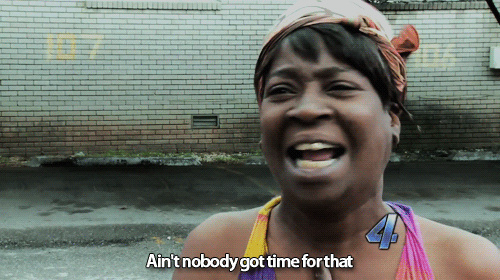Throw out everything you know about writing! The Internet has its own set of rules for writing. If you're going to communicate value to your customers, you have to do it on their terms. That means writing articles they want to read, how they want to read them.
As an inbound marketing agency, we write a lot of articles and eBooks for our clients. Without fail, every client has some reservations about our writing style at first. Why? Because it's different than what we were all taught in school.
The old rules of writing have changed for one main reason: the internet audience is impatient. Very, very impatient.
The internet is not like a magazine or novel where people are stretching back in a recliner and reading every word. Neither is it like a research paper where big words and high word counts impress the reader. It's an internet audience, and when it comes to fancy writing, "ain't nobody got time for that!"

The internet audience is looking for answers, and they want them fast. They don't read your articles; they scan them until they find exactly what they are interested in learning. Walls of text and articles that aren't broken into sections are intimidating to the reader who's in a hurry. When we encounter articles like this, most of the time, we bounce and move on.
That's why you need to adopt a new paradigm. Writing for the internet is it's own art form and the best artists practice the art of simplicity.
Rules of Writing for an Internet Audience
Forget what you know about writing, aside from basic grammar. We're going to look at some rules of what your writing should be like on your blog posts. Note: there are some exceptions to these rules, which we will talk about later.
Rule 1: Use Short Sentences and Paragraphs
Practicing brevity is one of the most important rules in blog writing. In school, we padded our paragraphs with fancy wording, and passive language to fluff our papers to a certain word count. That shouldn't happen on the internet.
If you can cut any words from your sentences, do it. Some writers even suggest going sentence by sentence and editing until you can get it into its shortest form. I'm not quite that extreme, but you should keep sentences as short as possible.
Short and simple goes for paragraphs too.
As I said earlier, internet readers are in a hurry. When they experience a wall of text, it discourages them and makes them feel like reading your article is going to be a lot of work. Short paragraphs give the illusion they are making progress quickly and inspires them to keep reading.
Rule 2: Use Simple Words
Too many companies try to write like their ultimate goal is to impress a jury of linguistic professors with their vocabulary. If the average reader has to look up a single word in the dictionary, you've lost them.
Instead, use words everyone uses. Some experts recommend writing for an 8th-grade reading level. For stuffier companies, this might not be the best advice. But you should still strive to use words the layman will quickly consume and understand.
Rule 3: Use Headings and SubHeadings
For goodness sakes, make your article scannable. Most people aren't interested in reading. They want an answer to a question. When you write an article like, "How Much Does a Freelance Writer Cost," those who read that article are looking for one thing - pricing information.
Don't make them wander through a jungle of text to find where you start talking about price. Instead, break it up into headings so they can skip to the section that interests them the most.
Few visitors to your blog are going to read every word. Very few.
Don't write for the small minority who desire to read a beautiful and entertaining article. Instead, focus on the vast majority who want information quickly, easy to understand, and a snap to find.
Rule 4: Set Value Expectations in the First Paragraph
What is your article going to give the reader? Tell them in the first paragraph. That first paragraph should set the expectations for the rest of the article.
Next to the headline, the first paragraph is the most important part of your article. If you can't hook the reader in the first couple sentences, they won't read your article. So make it good, and let them know what they will get out of it.
Rule 5: Stay On Topic
I don't know how many articles I've written where I've found myself four paragraphs into another subject. For instance, I'm writing about the cost of glue and I write an entire section on which kind of glue is stickiest.
The truth is, writing about something pertaining to the subject is a distraction to the subject. If it's important to the topic, make it another article and then link to that article in a simple sentence.
Here's a little tip on how I write blogs and expand my topics to multiple articles. I start writing one article, and if I find myself writing about something outside of the main subject too long, I pause the main topic blog. I take the section I've been writing and turn it into its own blog post. Then, I go back to the main blog and cut the non-essential section, and replace it with a short reference hyperlinked so they can go learn more about that subject matter if they want.
Here's an example, take the previous paragraph and turn it into its own blog post. Then, instead of explaining it, link to it. (I didn't do it this time.)
Rule 6: Cut As Much as Possible
I follow this rule when I write blog posts: write without second-guessing, and then cut without second-guessing. Don't try to edit your blog post when you're writing. Just write.
Once you've finished your article, go back and cut fluff with a machete, not a scalpel. Anything that isn't essential, cut it out. That includes sentences, paragraphs, stories - anything that doesn't add value.
Why explain something in 5 paragraphs when you can do it in 2 sentences?
Remember, the internet audience is looking for information, and they want it fast. An article that answers their question in two sentences is more valuable than an article that overly explains it in 5 paragraphs.
Rule 7: Cut the Running Starts
In her book, "Everybody Writes," Ann Handley talks about some writers take a running start approach to their writing. In working up to the main idea, they back way back and write about everything leading up to the main idea. She calls it, "The Running Start."
This goes hand in hand with rule #6, but if you find yourself backing too far off a main idea in your introductions, cut them. You'll usually find running starts in your first few paragraphs, and sometimes after each heading.
Ask yourself, "does this really need to be included for the article to make sense?" If not, cut it.
Improving Your Blog Writing Skills
We have had clients in the past who thought these rules were beneath their brand. These clients usually end up receiving little benefit from their blog articles. The main thing to remember when writing for your company blog, regardless of whether you're a startup or a large enterprise is this: you're not writing for your co-workers or competitors. You are writing for your customers.
There are exceptions to these rules for certain kinds of writing. Usually, the exceptions are established thought leaders who have a dedicated audience. These rare individuals have readers that read for the value of the author. They aren't reading to find answers to their questions. With that said, even some of the greatest thought leaders follow these rules anyway.
The bottom line is this: write the way your customers want to read. If they want leisure reads, by all means write long, entertaining articles.
But if they are searching for answers for your value, your pricing, you vs. your competitors, your methods and processes, or anything else pertaining to your products or services - give them what they want.
Nine times out of ten, they want quick, scannable, simple articles that address their questions and pain points.
Adopt the simplicity - wow your customers.





